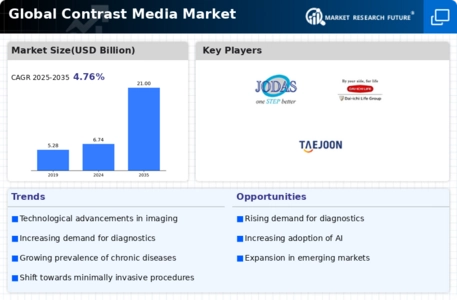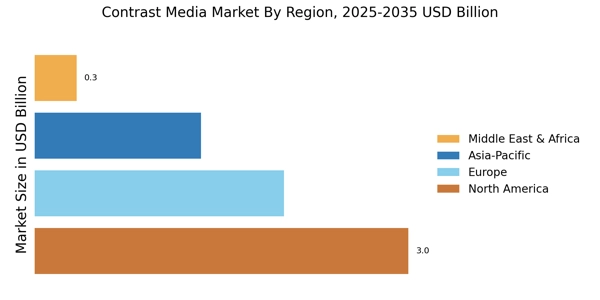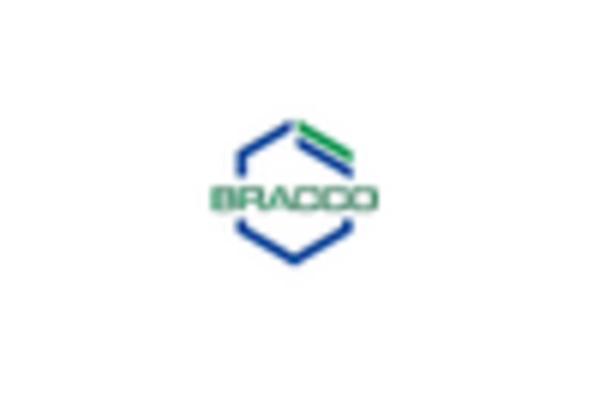Rising Incidence of Chronic Diseases
The increasing prevalence of chronic diseases such as cancer, cardiovascular disorders, and neurological conditions is a primary driver of the Contrast Media Market. As these diseases require advanced imaging techniques for diagnosis and monitoring, the demand for contrast media is expected to rise. According to recent statistics, the incidence of cancer is projected to increase, leading to a higher need for imaging modalities like MRI and CT scans, which utilize contrast agents. This trend indicates a growing market for contrast media, as healthcare providers seek effective solutions for accurate diagnosis and treatment planning. Furthermore, the aging population is likely to exacerbate this trend, as older individuals are more susceptible to chronic conditions, thereby further propelling the demand for contrast media in medical imaging.
Increase in Diagnostic Imaging Procedures
The rising number of diagnostic imaging procedures is a crucial driver of the Contrast Media Market. As healthcare systems increasingly rely on imaging for accurate diagnosis, the demand for contrast media is likely to grow. Reports indicate that the number of CT and MRI scans performed annually has surged, reflecting a shift towards more comprehensive diagnostic approaches. This increase is attributed to the growing awareness of the importance of early disease detection and the advancements in imaging technology that facilitate these procedures. Consequently, the contrast media market is poised for growth, as healthcare providers seek to enhance the effectiveness of imaging studies through the use of high-quality contrast agents. This trend underscores the essential role of contrast media in modern diagnostic practices.
Growing Awareness of Preventive Healthcare
The increasing emphasis on preventive healthcare is driving the demand for diagnostic imaging, thereby influencing the Contrast Media Market. As patients and healthcare providers recognize the importance of early detection and intervention, the utilization of imaging techniques that require contrast media is likely to rise. Educational campaigns and public health initiatives are fostering a culture of preventive care, leading to more individuals seeking regular health screenings that incorporate advanced imaging. This trend is expected to boost the demand for contrast agents, as they play a critical role in enhancing the quality of imaging studies. Consequently, the contrast media market is positioned for growth, as it aligns with the broader shift towards preventive healthcare practices that prioritize early diagnosis and treatment.
Technological Innovations in Imaging Techniques
Technological advancements in imaging modalities are significantly influencing the Contrast Media Market. Innovations such as 3D imaging, hybrid imaging systems, and enhanced MRI techniques are driving the adoption of advanced contrast agents. These technologies improve diagnostic accuracy and patient outcomes, leading to an increased utilization of contrast media. For instance, the development of gadolinium-based contrast agents has revolutionized MRI imaging, providing clearer images and better diagnostic capabilities. The market for contrast media is expected to expand as healthcare facilities invest in state-of-the-art imaging technologies, which require sophisticated contrast agents to enhance image quality. This trend suggests a robust growth trajectory for the contrast media sector, as it adapts to the evolving landscape of medical imaging.
Regulatory Support for Advanced Imaging Solutions
Regulatory bodies are increasingly supporting the development and approval of advanced imaging solutions, which is positively impacting the Contrast Media Market. Initiatives aimed at expediting the approval process for new contrast agents and imaging technologies are likely to foster innovation and enhance market growth. For example, regulatory agencies have introduced frameworks that facilitate faster access to novel contrast media, ensuring that healthcare providers can utilize the latest advancements in imaging. This regulatory support not only encourages research and development but also enhances patient access to cutting-edge diagnostic tools. As a result, the contrast media market is expected to benefit from a more favorable regulatory environment, promoting the introduction of innovative products that meet the evolving needs of healthcare professionals.


















Leave a Comment